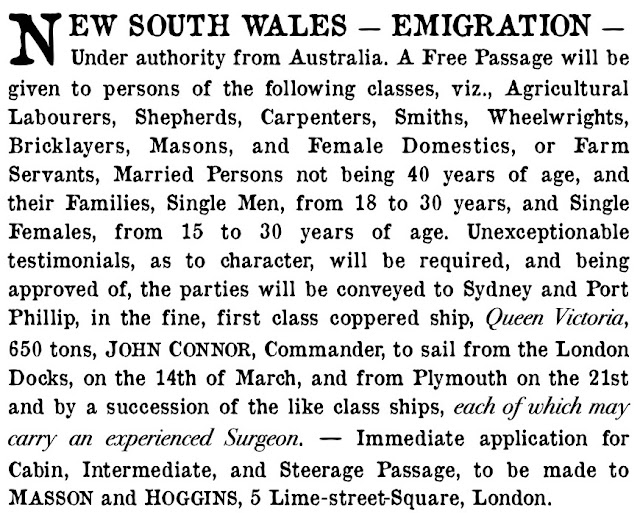 |
| Swan River Colony, 1829. |
Captain James Cook first colonised Australia in 1770. The first convicts arrived in 1788 to establish New South Wales as a penal colony. During the following sixty years, the British Government transported over 162,000 convicts to Australia. Of these, almost 90% were men. Ages ranged from 9 to over 80 years.
Sentences were harsh in the 1800s. Over two hundred crimes could result in execution, some by gruesome means. Most death sentences were for non-violent property crimes, over half for a first offence. So it was common to commute to transportation for between three years and life. There was no procedure for return after the sentence had been served. Thus, very few of those transported ever returned home. Transportation was effectively banishment for life.
After serving roughly half their sentence or about 12 years if a life sentence, convicts could be issued with a Ticket of Leave. This entitled them to certain freedoms such as the right to marry, bring their families from Britain or to acquire property. Those who served out their full sentence or were granted a pardon usually remained in Australia as free settlers.
The Colonial Government encouraged immigration, believing this was essential for economic growth and security. Huntingdonshire papers carried adverts for settlers to Swan River Colony (today's Perth, Western Australia) as early as 1829. Later, the Government offered immigrants from Great Britain free passage.
 |
| Cambridge Independent Press emigration advert, 1841 |
Starvation and disease at home forced many to seek a better life in Australia. The Irish Potato Famine resulted in many emigrating from Ireland. Australia was the major destination for Scots fleeing the Highland Clearances. From the late 18th century, the industrial revolution led to huge urbanisation and mass migration of population from working on the land to cities. Overcrowding and unemployment resulting from a quadrupling of population in just one hundred years created desperate conditions and a population ready for a better life.
New South Wales experienced the first Australian gold rush from 1851 to 1880. There was a rapid expansion of population and a significant boost to the economy. In 1852, prospectors found over 24 tons of gold.
Most emigrants travelled by the cheapest means. Ship owners treated steerage class passengers like cattle. A stroll on deck was the only chance to breathe fresh air. During inclement weather passengers were forced down into steerage. Seasickness and poor sanitary arrangements created nightmare conditions. There was no privacy. Several hundred passengers slept in one compartment in what were often converted cargo holds. Bunks were stacked one above the other with no natural light. Food was unappealing, doled out in enormous pots.
 |
 |
 |


No comments:
Post a Comment